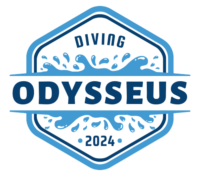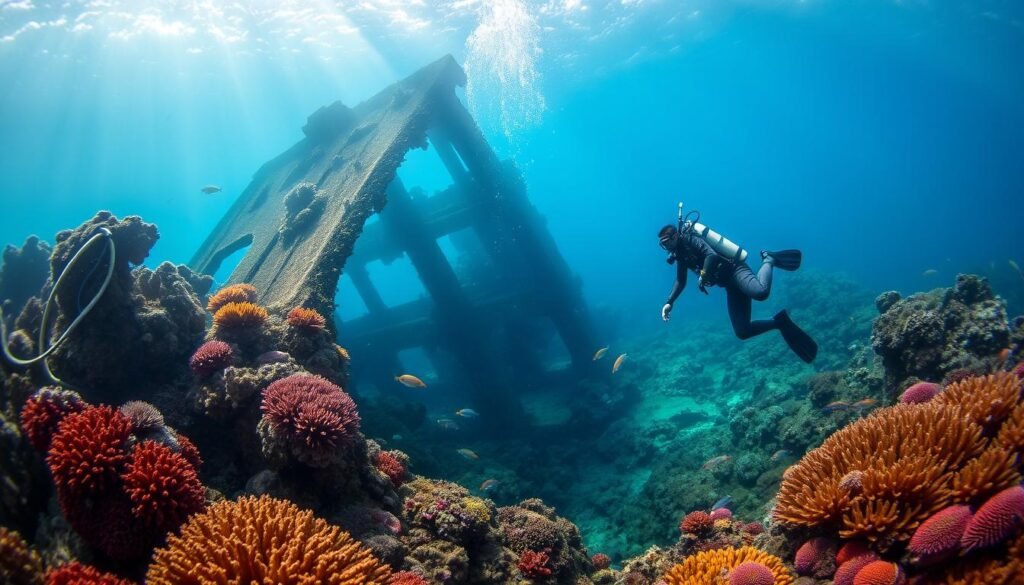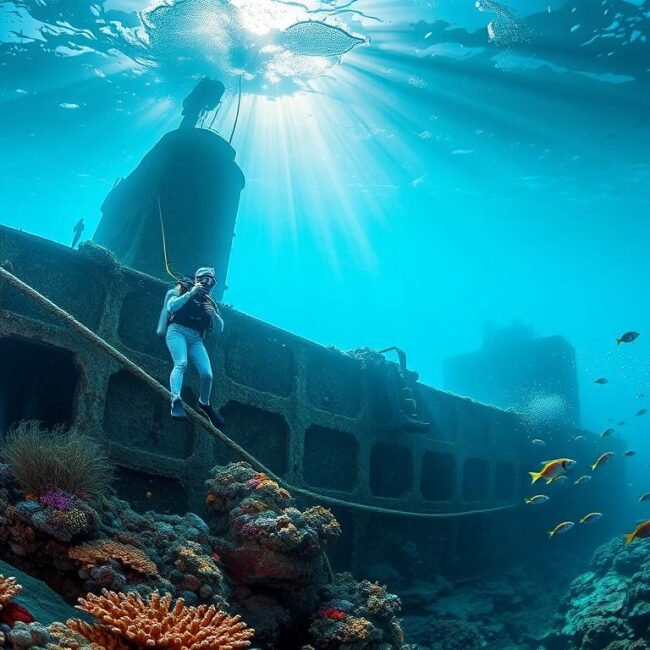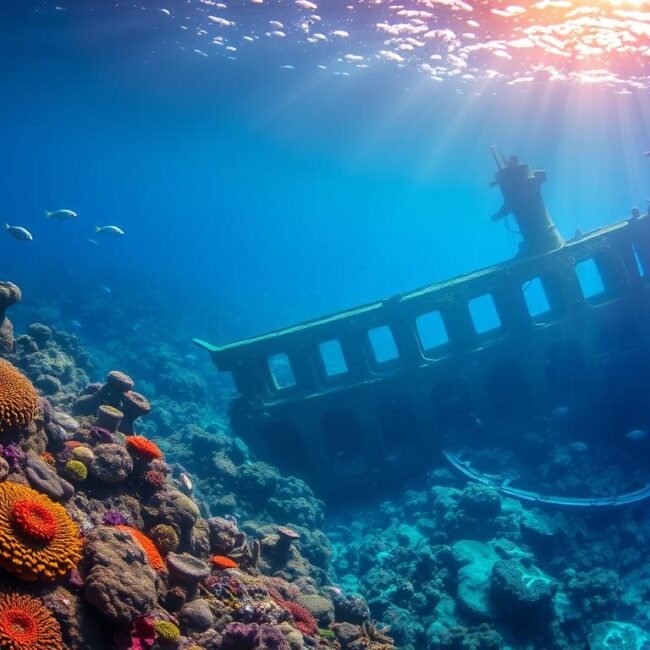“Did you know that there are over three million shipwrecks scattered across our planet’s oceans?” This fact amazed me and sparked my interest in advanced wreck diving courses. Who wouldn’t want to explore the dark corridors of old warships or find a sunken cargo freighter full of marine life?
Advanced wreck diving isn’t just for experts. It’s for anyone who loves maritime history, seeks underwater challenges, or is fascinated by the ocean’s secrets. The thrill of diving near a massive hull that once sailed the seas is exhilarating!
My first advanced wreck dive was nerve-wracking. But with training and experience, I learned it’s all about preparation and pushing your limits. With the right skills and guidance, wreck diving becomes a thrilling adventure.
Let’s dive into what makes advanced-wreck-diving-courses so exciting. We’ll cover the skills you need and how to choose the best program. We’ll also explore amazing dive sites, safety tips, and how to keep improving. So, get ready to explore the mysterious world of advanced wrecks!
Understanding the Appeal of Advanced Wreck Diving
The Allure of Discovering Hidden Maritime History Beneath the Waves
One of the coolest moments was watching my dive buddy’s torch light up a century-old cargo ship at 100 feet. It made me think of the sailors who once called that deck home. Drifting over broken hulls and crates, piecing together history underwater is thrilling.
My first real moment of understanding was in a half-collapsed engine room. Shining my light on pipes and machinery covered in coral and fish, I imagined the crew’s daily routines. It’s like time-travel with scuba gear and solid training.
I’ve had moments of fear, wondering if it’s safe or what if I get stuck. But preparedness and proper courses make it worth it. Exploring history underwater is awe-inspiring and makes the nerves worth it. Over time, you learn to respect these sites, blending awe with caution.
Advanced wreck diving also gives you bragging rights. Telling friends you’ve explored sunken battleships and old submarines gets their attention. It’s not just diving—it’s rewriting what’s possible underwater.
Experiencing the Thrill of Deeper, More Complex Wreck Sites
Diving on advanced wrecks is like exploring an abandoned mansion. Each room tells a new story. The deeper you dive, the more exciting it gets
My first deep dive was unforgettable. I went past 130 feet and felt my breathing slow. The ship loomed large, and my flashlight showed hidden corners full of life and forgotten cargo. It was both spooky and thrilling.
Deep diving pushes your limits and tests your training. It’s not just about kicking harder. You learn to control your buoyancy and trust your gear in the dark. Every second underwater feels like a victory as you explore steel passageways unseen by many.
Gaining Access to Exclusive Dive Locations Not Open to Beginners
Advanced-wreck-diving-courses unlock secret dive spots closed to beginners. It’s like having an all-access pass to nature’s backstage.
My friend tried sneaking onto a wreck dive without proper training. They were turned away, and it was the right call. Advanced training shows you’re ready for these environments. It proves you’re not just a tourist but an adventurer who values safety and skill.
These restricted sites have more intact structures, cool artifacts, and vibrant marine life. Accessing them feels like joining an elite club. With each advanced certification, you unlock more challenging and breathtaking wrecks, revealing a world of underwater wonders.
Appreciating Unique Marine Life Found In and Around Submerged Structures
Wrecks are more than old metal; they’re ecosystems. Fish, sponges, corals, and other marine critters turn these giants into underwater cities. I’ve swum through corridors filled with glassfish and met curious groupers.
On one dive, I met a turtle in a cabin window. It was a surprise. Seeing marine life in wrecks taught me they’re not just metal but shelters and hunting grounds.
After advanced dives, you expect the unexpected. You might find a big grouper or a rare nudibranch. This diversity makes each dive a wildlife safari with a historical twist. The mix of history and biodiversity keeps me coming back.
READ MORE: Top 10 Wreck Diving Sites for Adventure Seekers
Essential Skills and Prerequisites
Mastering Buoyancy Control to Navigate Tight, Enclosed Spaces
Buoyancy control can be tough at first. I remember flailing around in my early days, kicking up silt and feeling like a total goof. But when it comes to advanced-wreck-diving-courses, mastering buoyancy is absolutely crucial.
Imagine gliding through a narrow passage inside a wreck. If you’re too buoyant, you’ll smash into the ceiling. Too heavy, and you’ll scrape along the floor, stirring up clouds of rust and gunk that reduce visibility to near zero. After some practice, I learned to fine-tune my breathing and adjust my weight system so I could hover with finesse.
It took a bunch of tries, and I’m not ashamed to admit I got frustrated. But one day, everything clicked, and I slipped through a tight doorway without even touching the sides. That sense of accomplishment made me grin like a fool behind my regulator. Proper buoyancy control will turn a hectic, clumsy dive into a smooth, stress-free adventure.
Achieving Advanced Certifications for Deeper and More Technical Dives
If you want to explore deeper wrecks safely, you’ve got to level up. Advanced certifications aren’t just pieces of paper; they’re proof you’ve put in the time, learned the skills, and taken the safety training seriously. It’s like going from a learner’s permit to a full driver’s license for underwater highways.
I remember studying decompression theory late into the night, my brain spinning with all the tables and gas mixes. It wasn’t glamorous, but when I finally emerged on the other side with my advanced ticket, I felt unstoppable. With these certs, you can push beyond the shallow playground and enter a world filled with bigger challenges and bigger rewards.
Plus, instructors and fellow divers will respect you more when they know you’re properly trained. It’s not about bragging; it’s about being part of a community that values skill, safety, and constant improvement. Advanced certifications let you show that you’re serious about this passion and ready for the big leagues.
Building Core Competencies in Navigation, Line Laying, and Penetration Techniques
Navigation inside a wreck is like solving a puzzle in low light. If you don’t lay lines properly, you risk losing your way, which can lead to panic or worse. During my training, I learned to run a reel line through corridors, tie off at key points, and retrace my path like a breadcrumb trail.
At first, I tangled my lines and got them caught on every darn protrusion. It was a nightmare. But after a while, I improved my technique, learned to move slowly and deliberately, and developed a calm rhythm that kept everything orderly.
Penetration dives, where you go inside the wreck, are risky but oh-so-rewarding when done right. You gain confidence every time you complete a successful penetration and safely return. Soon, you realize that careful planning and proper line-laying are your best friends down there.
Improving Situational Awareness and Underwater Communication
Underwater communication can be tricky since we can’t just chit-chat like we’re at a bar. Hand signals, light signals, and body language become your new language. I still remember the first time I tried to signal a friend that I was low on air and he thought I was dancing.
Situational awareness means keeping track of your surroundings, your team, and your gear all at once. Is that your buddy behind you, or just a shadow on the wall? Are you near your planned exit point, or drifting off course? With practice, you develop a kind of sixth sense that helps you navigate safely.
This heightened awareness and strong communication skills become second nature after enough dives. Eventually, you’ll glide through a wreck with your buddy, exchange a few signs, and know exactly what to do—no words needed. It’s magical how well you can work together under these extreme conditions.
“The advanced wreck diving course was a game-changer for me. It not only enhanced my skills but also instilled a deep sense of respect and appreciation for the submerged historical treasures I had the privilege to explore.”
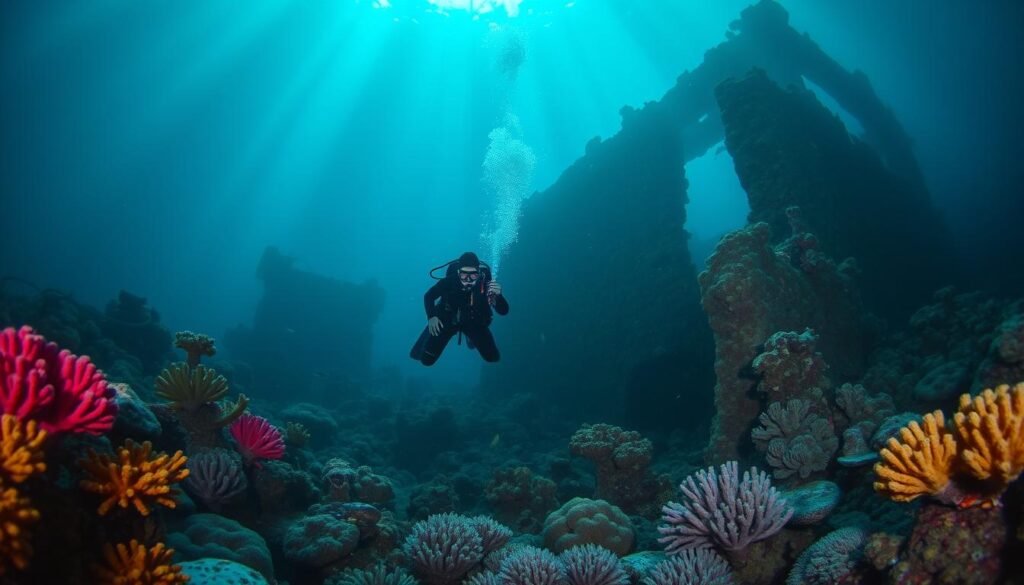
Types of Advanced Wreck Diving Courses
Technical Wreck Diving Courses Focusing on Deeper Penetration
If you love diving deep and exploring wrecks, technical courses are for you. They teach you to handle complex dives and manage gas mixes. It’s like learning to drive a race car after mastering a family sedan.
My first technical course was overwhelming. But with training and guidance, I learned it’s just a step-by-step process. Tech courses make you a thinking diver, ready for any challenge.
Deeper dives become safer and more controlled after you learn. You’ll explore wrecks further and discover new areas. It’s challenging but rewarding.
Courses Specializing in Sidemount or Closed-Circuit Rebreather (CCR) Configurations
Sidemount and CCR courses are like customizing your car. Sidemount tanks are at your sides, improving your dive. CCR units let you breathe recycled gas, extending your dive time.
Switching to sidemount was weird at first. But it offers better access to valves and trim in the water. It also lets you squeeze through tight spots without banging tanks.
CCRs require serious training and patience. They offer silence and longer dives, revealing wreck parts you’d never see on open circuit. These specialties offer a new way to explore wrecks.
Specialty Programs for Photographing and Documenting Wreck Sites
Some advanced courses focus on photography. I took a course expecting it to be easy, but it was tough.
Balancing lights, camera gear, and buoyancy for the perfect shot was challenging. But with practice, I learned to slow down and anticipate the perfect moment.
Documenting wrecks is about recording history and sharing stories. Capturing a sharp image of a hidden cargo hold felt like creating a time capsule. This specialty turns you into a visual storyteller, preserving wrecks for future divers.
Wreck Salvage and Archaeological Survey Training
Salvage and archaeological courses offer a deeper purpose. You learn to handle artifacts responsibly and conduct surveys. It’s serious work, diving to understand and preserve history.
I volunteered on a survey team for a small cargo wreck. It was slow but satisfying work. This training makes you appreciate wrecks as cultural touchstones, not just playgrounds.
You learn to document sites better than you found them, ensuring future generations have a clear record. Whether cataloging old crockery or mapping a hull, this training makes your dives meaningful.
Top Training Agencies and Certifications
PADI’s Advanced Wreck Specialties and Tech Programs
PADI is a big name in diving, known for their advanced wreck courses. I took a PADI advanced wreck course and found it easy to follow. It had the right mix of theory and practice.
It felt like joining a community with high standards and quality checks. Their technical programs teach you to dive deeper, always focusing on safety. While no agency is perfect, PADI’s global recognition opens doors worldwide. For beginners, PADI is often the next logical step.
SSI Extended Range Wreck Diving Courses
SSI offers flexible and modern training, with top-notch Extended Range courses. An SSI instructor I spoke with praised their digital materials and easy learning system. It seemed more flexible and up-to-date with the latest diving gear and techniques.
SSI encourages ongoing learning and skill improvement, letting you progress at your own pace. Their certifications are widely accepted, so you can show off your skills anywhere. It’s about building confidence and experience in wreck diving, not just passing a course.
NAUI and TDI Wreck Diving Certifications for Technical Divers
NAUI and TDI are known for their tough standards in tech diving. They dive deep into decompression theory, equipment redundancy, and advanced penetration methods. It’s serious, but perfect for those who want to dive hardcore.
I once talked to a TDI instructor who said, “We don’t just train you to dive; we train you to think like a problem-solver.” This attitude really resonated with me, especially after facing unexpected problems underwater. NAUI and TDI courses give you a solid foundation, ensuring you can handle tough situations.
GUE’s Exacting Standards for Exploration-Level Wreck Training
GUE is known for being very strict and detail-oriented. Their courses focus on teamwork, standardization, and precise techniques. This is where the pros go for top-tier performance and exploration-level diving.
I haven’t taken a GUE course myself, but I’ve met divers who have. They talked about the discipline and unity of diving as a well-drilled team. It’s intense, but if you want to explore legendary wrecks and push boundaries, GUE’s training can refine your skills to the max.
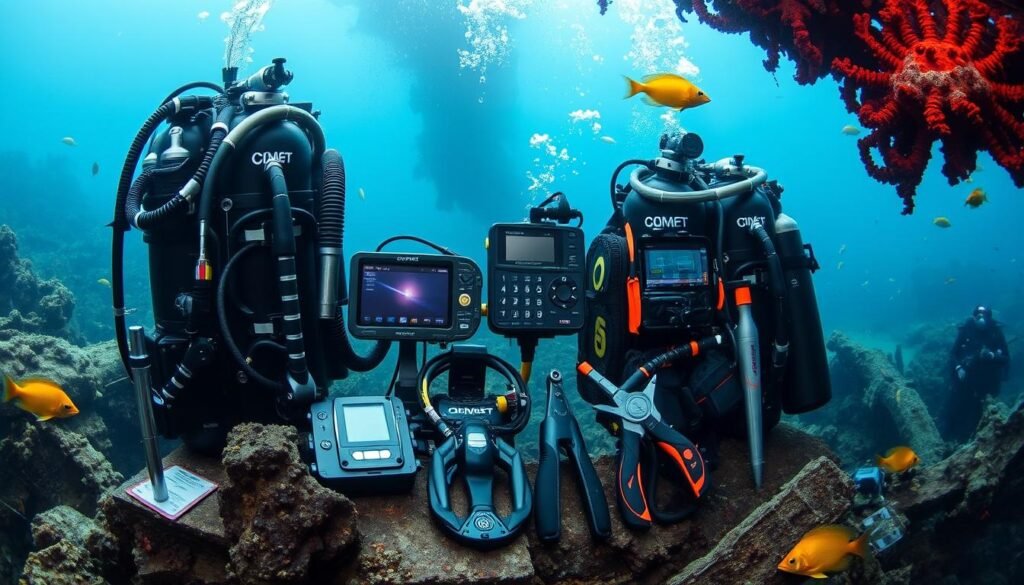
Equipment and Gear Considerations
High-Quality Dive Lights, Reels, and Spools for Penetration and Navigation
Diving in a wreck without a good light is like walking in a cave without a flashlight—it’s not good. I’ve tried many dive lights, but some flickered at the worst times. Others didn’t shine bright enough.
So, I chose a strong primary light and a couple of backups. Reels and spools are like your safety lines. Cheap ones can jam or tangle, making you curse underwater. Investing in quality ones saves a lot of trouble.
After getting a better reel, I felt confident laying line in narrow passages.
Redundant Air Sources, Stage Bottles, and Backup Systems for Safety
When diving deep in a wreck, you can’t just surface if something goes wrong. Having extra air sources, like pony bottles or stage tanks, is crucial. I once had a minor hiccup with my regulator inside a wreck—it was a reminder that having backups is important.
Plan your air supply carefully and bring more than you think you’ll need. This way, you’ll feel safer, knowing you have options if something unexpected happens. Safety gear is not just a checklist item; it’s your peace of mind in a cold, dark place.
Specialized Wetsuits or Drysuits for Thermal Protection
Wrecks often lie in cooler waters, and staying warm is key. I switched to a drysuit because my teeth were chattering after long dives. It took some getting used to, especially managing buoyancy changes.
But once I got the hang of it, I could dive longer without freezing. Staying warm affects your mental state and energy levels. Being cold can lead to poor decisions, so invest in proper protection for a safer dive.
Cameras and Strobes for Capturing Historic Wreck Features
Capturing images of a wreck is like taking souvenirs that last forever. I started with a basic GoPro and then moved to a proper underwater camera with strobes. The difference was huge!
Strobes bring out the true colors and details of corroded metal and marine life. Remember, controlling lighting and composition underwater is tricky. With patience, you’ll create images that let you relive each dive and show friends why advanced-wreck-diving-courses were worth every penny.
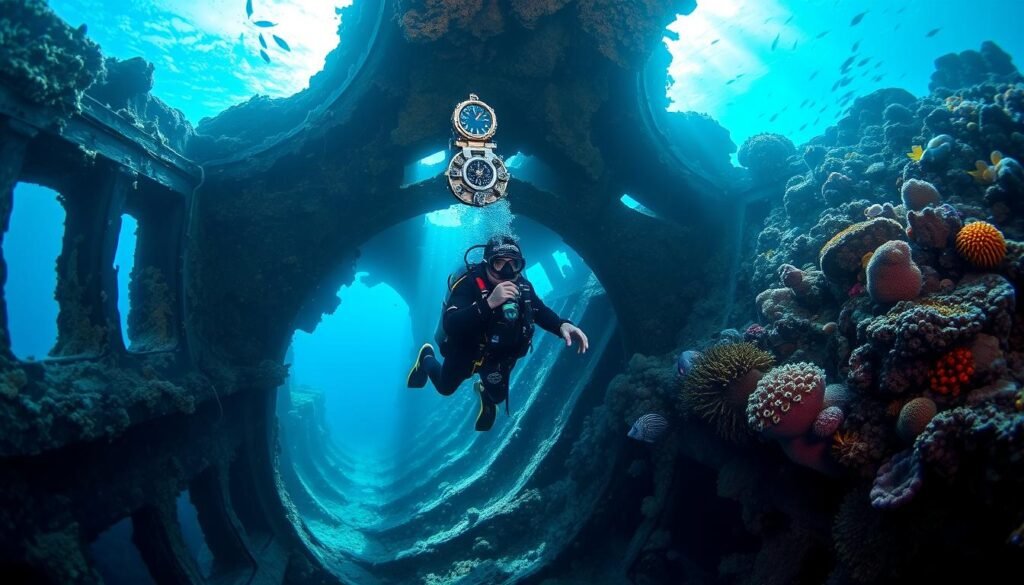
Selecting the Right Course for Your Goals
Determining Your Preferred Depth Range and Complexity of Wrecks
Before signing up for any advanced-wreck-diving-courses, ask yourself: how deep do you want to go? Maybe 100 feet is enough, or maybe you’re itching for 200-foot expeditions. Knowing your comfort zone helps narrow down course options.
I realized I prefer mid-range depths where I can still enjoy good light penetration. Too deep, and it gets pitch-black and more gear-heavy. Knowing your sweet spot ensures you pick training that matches your aspirations, not just what sounds cool.
Assessing Personal Comfort Level and Current Skill Set
Be honest with yourself. Are you a confident diver, or do you still get nervous in enclosed spaces? Before I pursued advanced training, I spent months improving my buoyancy and trim. That foundation made the advanced stuff less intimidating.
If you feel shaky, consider a few intermediate steps first. There’s no rush; taking it slow builds a stronger skill base. Trust me, the last thing you want is to pay for a course you’re not ready for.
Considering Instructor Experience, Reputation, and Teaching Style
A great instructor can make all the difference. Some are patient and methodical; others push you harder. I learned the hard way by once choosing a course based solely on price. Big mistake.
When I found an instructor who communicated clearly, gave constructive feedback, and matched my learning pace, I progressed faster and felt safer. Read reviews, talk to former students, and pick someone you click with. Your instructor will shape your experience, so choose wisely.
Evaluating Course Duration, Cost, and Location Convenience
Advanced wreck courses aren’t cheap. Gear rental, travel, materials—it adds up. But investing in quality training pays off long-term.
Also, think about convenience. If the course location is too remote, will you be stressed just getting there? Balancing cost, travel time, and course length ensures you can focus on learning, not logistics. In the end, choose the course that fits your budget, schedule, and goals, so you walk away thrilled, not frustrated.
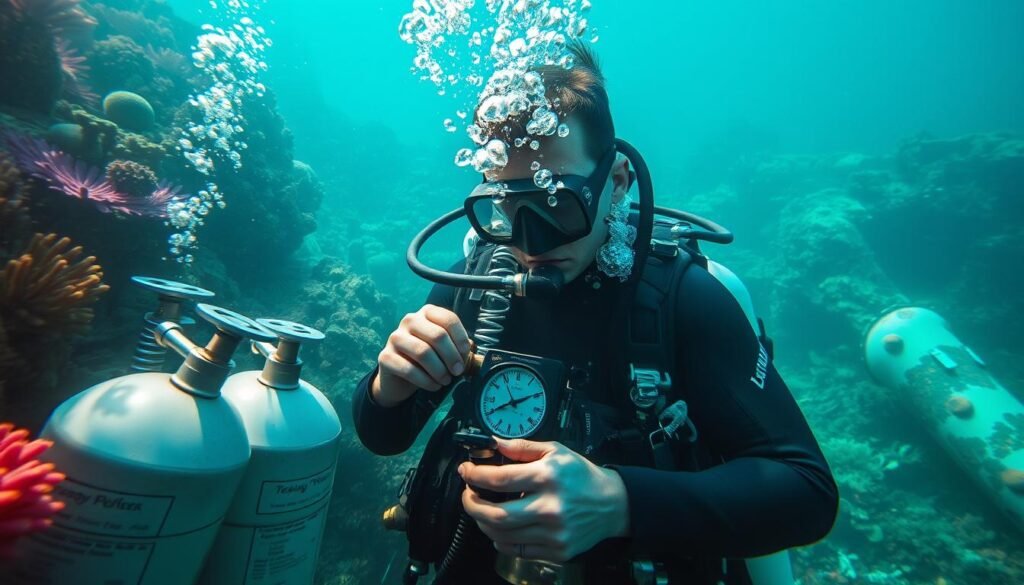
Safety Measures and Emergency Procedures
Proper Planning, Gas Management, and Dive Team Coordination
A good plan reduces the chance of surprises. Before each dive, my team and I discuss our route, gas limits, and signals. We double-check each other’s gear and agree on what to do if something goes south.
Gas management is critical. Running out of air deep in a wreck is a nightmare scenario. With thorough planning, everyone knows their role, and we start the dive confident, not anxious.
Adhering to Penetration Protocols and Maintaining Continuous Lines
When penetrating a wreck, maintaining a continuous guideline is non-negotiable. If silt kicks up and visibility drops, that line is your lifeline back to the exit. I once lost sight of my buddy in a silty corridor—terrifying. But because we followed protocols and stuck to the line, we found each other and exited safely.
Penetration protocols aren’t just stuffy rules; they save lives. They make sure no matter how disorienting the interior gets, you have a path home.
Decompression Stops and Following No-Deco or Mixed-Gas Guidelines
Dives that push depth and time often require decompression stops. It’s a waiting game, hanging mid-water, letting your body off-gas. I used to find it boring, but now I see it as a small price to pay for safer dives.
Following no-deco or mixed-gas guidelines is non-negotiable. Cutting corners can lead to serious health issues. With proper training, you’ll learn to trust the tables, the computer, and the plan, ensuring you surface feeling good.
Practicing Drills for Lost Lines, Entanglements, and Low-Visibility Scenarios
Before tackling advanced wrecks, we run drills for worst-case scenarios. We practice finding the line with eyes closed or dealing with a snagged fin. It’s not fun, but it builds muscle memory and confidence.
When I actually got snagged once, I didn’t panic. I remembered my training, moved slowly, and freed myself. Drills prepare you for the real deal, making emergencies manageable, not catastrophic.
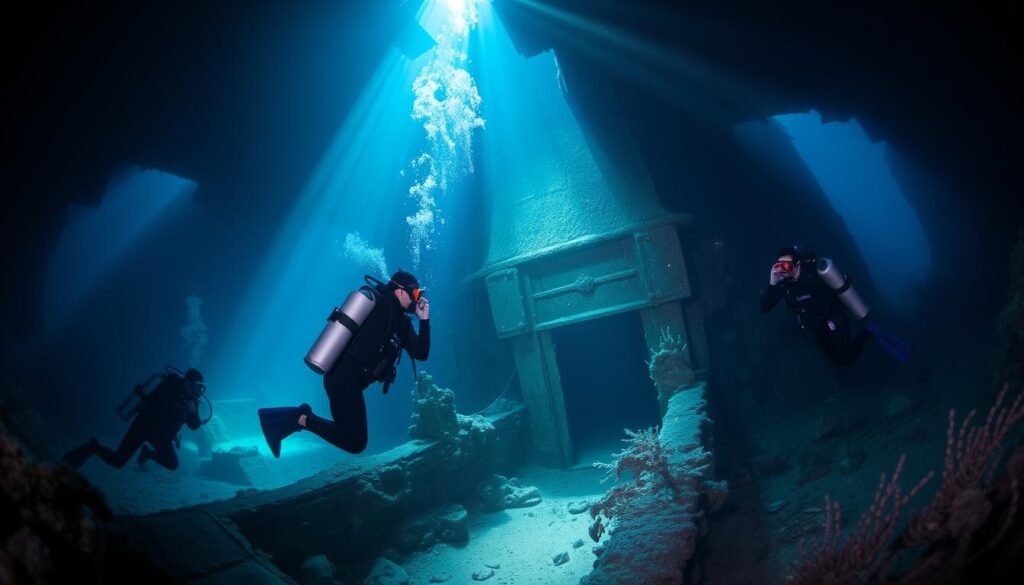
Noteworthy Wreck Destinations for Advanced Divers
Exploring the SS Thistlegorm in the Red Sea’s Clear Waters
The SS Thistlegorm is like a celebrity wreck, and for good reason. It’s filled with cargo holds of motorcycles, trucks, and rifles—WWII artifacts frozen in time. I remember my first dive there: crystal-clear water, loads of fish darting in and out, and a sense of awe that’s hard to describe.
This wreck hits the sweet spot: deep enough to be challenging, but not too extreme. It’s a perfect milestone in your advanced wreck journey. Trust me, few things compare to drifting over a motorcycle at 90 feet underwater.
Diving the Ghostly Corridors of the USS Spiegel Grove in Florida
The USS Spiegel Grove is huge, like an underwater playground. It has corridors and doorways that test your navigation and line-laying skills.
I felt tiny inside this giant ship, like an ant in a human’s living room. Each turn was mysterious and intriguing. It’s a great place to practice, as you can adjust your dive to your skill level.
Encountering WWII-Era Wrecks in Truk Lagoon, Micronesia
Truk Lagoon is famous among wreck divers. It has a fleet of Japanese ships, each with its own story and relics. Diving here is like stepping into a sunken war museum.
Visibility might not always be perfect, and you’ll need proper credentials and experience. But the reward is huge. I still remember seeing old gas masks and sake bottles—chilling reminders of the past. It’s a place that’ll stick in your memory long after you surface.
Marveling at the Massive Ghost Fleets of Scapa Flow, Scotland
Scapa Flow is known for its cold water, eerie atmosphere, and historical significance. German warships from WWI lie here, bringing history textbooks to life.
It’s not a tropical paradise, but there’s something hauntingly beautiful about these wrecks. They’re huge, challenging, and demand proper training. If you’re ready for a serious wreck adventure, Scapa Flow delivers an unforgettable experience.
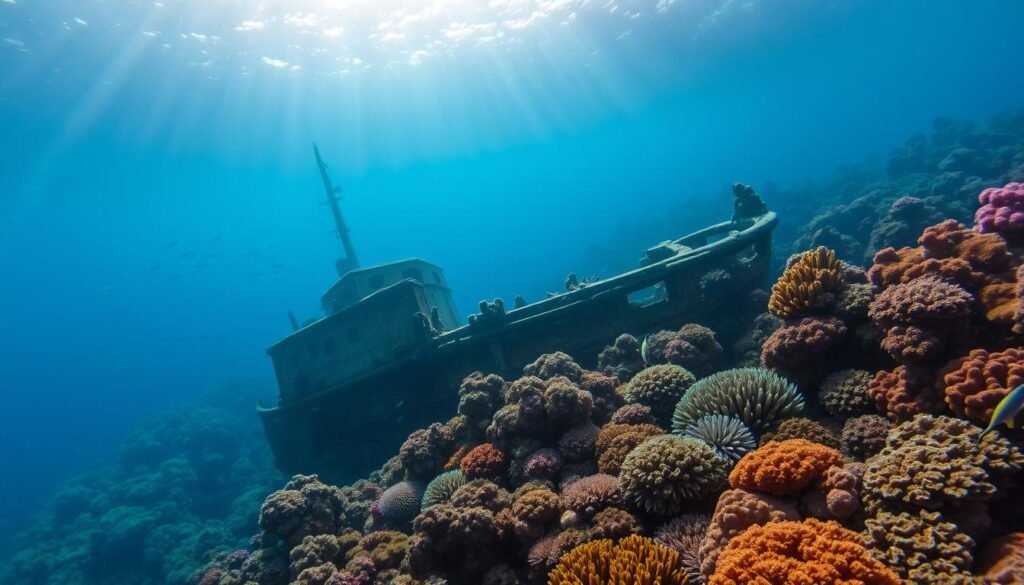
Tips for Ongoing Skill Development and Mastery
Participating in Regular Practice Dives and Refresher Courses
Skills fade if you don’t use them. I try to dive regularly, even just to practice buoyancy in a local lake. Refresher courses keep you sharp, reminding you how to lay lines properly or deal with gear failures.
Over time, these small tune-ups pay off big. You’ll remain confident, less rusty, and always ready for that next big wreck adventure.
Joining Local Dive Clubs for Mentorship and Community Support
Diving can feel lonely if you don’t know other divers. Joining a dive club changed everything for me. I met mentors who shared tips, invited me on trips, and helped me troubleshoot gear issues.
Community support means you learn from others’ mistakes, not just your own. Plus, swapping dive stories over a beer is half the fun.
Pursuing Advanced Technical Certifications and Specialty Workshops
If you find yourself craving more, don’t stop at one advanced course. Move into technical specialties, try CCR training, or take a photography workshop. It keeps things fresh and challenges you to grow as a diver.
I found that each new cert broadened my perspective, making me a more versatile diver. There’s always something new to learn, and that’s part of the thrill.
Keeping Current with New Technologies and Safety Standards
Diving evolves. New gear, new procedures, and better safety standards come out all the time. Stay updated by reading dive mags, following agencies’ blogs, or chatting with experienced instructors.
When a new gadget simplifies navigation or a new training method reduces accidents, embrace it. Adaptation keeps you at the cutting edge and ensures that every dive remains both exciting and safe.
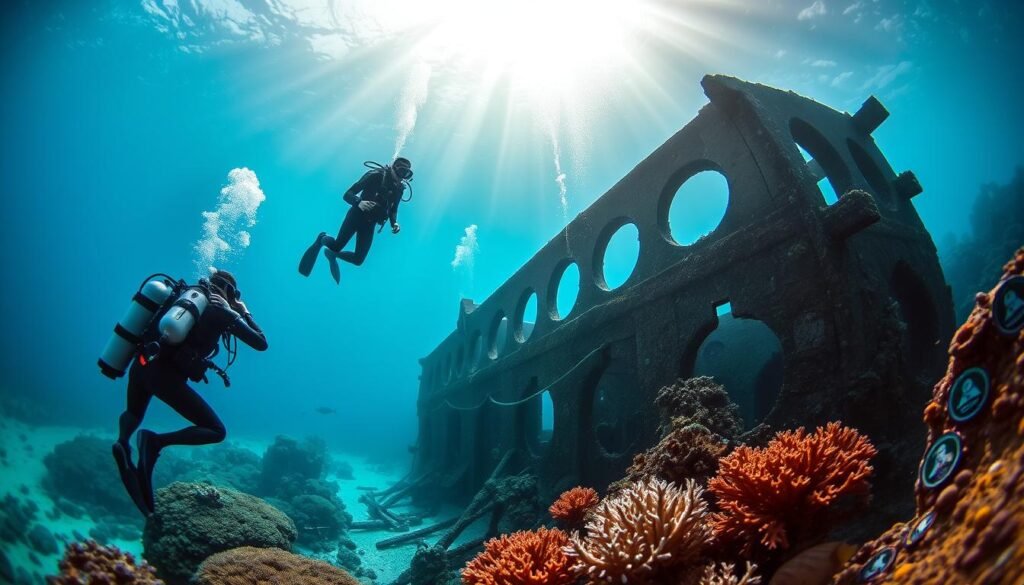
Conclusion
Advanced wreck diving courses open doors to secret underwater worlds. These worlds are filled with history, marine life, and personal growth. With the right training, skills, and gear, you can explore dark corridors, capture stunning images, or even contribute to archaeological research.
Remember to take it step-by-step. Build your foundation, choose the right course, and always respect the mysteries beneath the waves.
As you continue your journey, remember that safety is key. No dive is worth risking your well-being. Keep practicing, stay curious, and customize your training as your interests evolve.
If you’ve got your own wreck stories or tips, don’t hold back—share them. Learn from others, and keep exploring. The ocean’s got plenty of secrets left for us to discover, so let’s gear up and get after it!
FAQs
Do I need a specific certification before enrolling in advanced-wreck-diving-courses?
Typically, yes. Most training agencies require you to have at least an Advanced Open Water certification and a certain number of logged dives. Check with the specific course provider for their prerequisites.
How long does it usually take to complete an advanced wreck diving course?
The duration varies depending on the agency and the course complexity. Many programs last several days to a week. This allows for classroom sessions, skill drills, and multiple practice dives to build confidence and competence.
What type of gear is essential for advanced wreck diving?
Essential equipment often includes a high-quality dive light (plus backups), a cutting tool, reels or spools for guideline management, and appropriate exposure protection (wetsuit or drysuit). Depending on the course, you may also need redundant air sources and specific technical gear like sidemount tanks or a rebreather.
Are advanced wreck dives more dangerous than regular scuba dives?
Advanced wreck dives do come with increased risks due to overhead environments, potential entanglements, and deeper depths. However, proper training, adherence to safety protocols, and practicing emergency drills can significantly mitigate these risks. This makes the dives both thrilling and manageable.
Can I combine other specializations, like photography or archaeological survey, with advanced wreck training?
Absolutely! Many training agencies offer specialty courses that complement advanced wreck diving. You can learn underwater photography techniques to document wrecks or train in archaeological survey methods to help preserve maritime history—all while enhancing your overall wreck-diving skill set.
